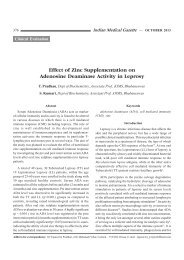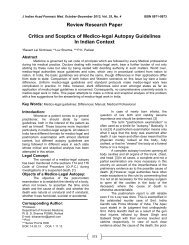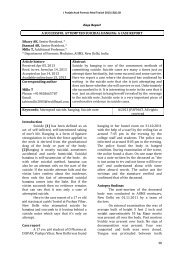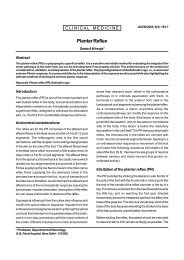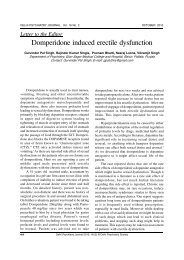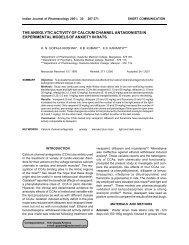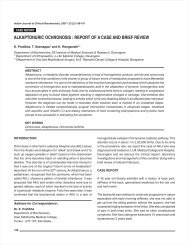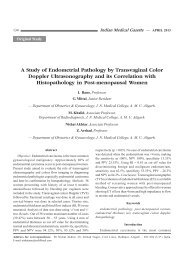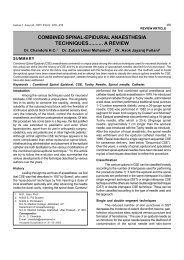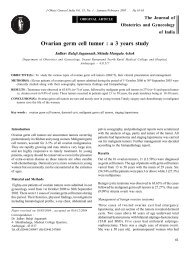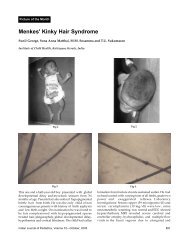Letters to the Editor - medIND
Letters to the Editor - medIND
Letters to the Editor - medIND
You also want an ePaper? Increase the reach of your titles
YUMPU automatically turns print PDFs into web optimized ePapers that Google loves.
<strong>Letters</strong> <strong>to</strong> <strong>the</strong> Edi<strong>to</strong>r<br />
Bladder Rupture Following<br />
Voiding Cys<strong>to</strong>urethrography<br />
Urinoma is defined as an encapsulated<br />
collection of extravasated urine(1). In urinary<br />
ascites <strong>the</strong> capsule is <strong>the</strong> peri<strong>to</strong>neum. It usually<br />
occurs following renal trauma. One of <strong>the</strong><br />
iatrogenic causes, is urinary system trauma<br />
during voiding cys<strong>to</strong>urethrography (VCUG)<br />
(2).<br />
A 4½-month-old boy was referred <strong>to</strong> our<br />
clinic with <strong>the</strong> complaint of progressive<br />
abdominal distention for one week before<br />
admission. Additionally he developed oliguria<br />
and was anuric for two days. During ultrasonographic<br />
examination of <strong>the</strong> urinary<br />
system due <strong>to</strong> growth retardation and<br />
hypocalcemia, left renal grade 1 pelvicaliceal<br />
ectasy was detected. Twenty days before his<br />
admission VCUG was done <strong>to</strong> reveal any<br />
underlying disorder. In <strong>the</strong> following period a<br />
significant increase was observed in <strong>the</strong><br />
abdominal circumference.<br />
On admission <strong>the</strong> boy was anuric with<br />
severe abdominal distention. He was<br />
minimally dyspneic with no respira<strong>to</strong>ry sounds<br />
at <strong>the</strong> lower thoracal segments on auscultation.<br />
Cardiovascular examination was normal with<br />
a normal blood pressure value for his age. No<br />
peripheral edema was observed. Urinary<br />
ca<strong>the</strong>terization revealed no urine output<br />
during <strong>the</strong> following hours.<br />
The ascites fluid was cloudy yellow in<br />
appearance due <strong>to</strong> fibrin particles and a high<br />
polymorphonuclear leucocyte count (>1000/<br />
mm 3 ). Its density was 1020 and its biochemical<br />
profile was as follows: Urea: 110.7 mg/dL,<br />
Creatinine: 3.3 mg/dL, Na: 125.5 mEq/L, it<br />
was noted that <strong>the</strong> urea and <strong>the</strong> creatinine<br />
values were much higher than <strong>the</strong> blood<br />
values (Urea: 82.3 mg/dL, Creatinine: 1.68<br />
mg/dL).<br />
The patient had disproportionately low<br />
blood urea and creatinine levels for anuria of<br />
two days duration but had much higher urea<br />
and creatinine values in <strong>the</strong> ascites fluid<br />
compared <strong>to</strong> serum values. We suspected<br />
urine leakage in<strong>to</strong> <strong>the</strong> peri<strong>to</strong>neal cavity. On<br />
computerized <strong>to</strong>mography (CT) of <strong>the</strong><br />
abdomen a defect in <strong>the</strong> anterior wall of <strong>the</strong><br />
urinary bladder was revealed. The contrast<br />
material given in<strong>to</strong> <strong>the</strong> bladder was observed<br />
leaking in<strong>to</strong> <strong>the</strong> peri<strong>to</strong>neal cavity under X- ray<br />
proving a rupture in <strong>the</strong> bladder wall. Reevaluating<br />
<strong>the</strong> past clinical his<strong>to</strong>ry we found<br />
out that <strong>the</strong> VCUG performed 20 days before<br />
admission was <strong>the</strong> only possible cause of this<br />
rupture.<br />
As soon as <strong>the</strong> rupture was diagnosed <strong>the</strong><br />
bladder wall was mended.<br />
Complications in VCUG are infrequent.<br />
Most common ones are traumas <strong>to</strong> urethra and<br />
urinary bladder. Urinary bladder rupture,<br />
allergic reactions <strong>to</strong> <strong>the</strong> contrast material and<br />
knotting of <strong>the</strong> ca<strong>the</strong>ter inside <strong>the</strong> bladder may<br />
also be seen(2-5). As long as most of <strong>the</strong><br />
bladder is retroperi<strong>to</strong>neally placed, urine<br />
generally leaks retroperi<strong>to</strong>neally following<br />
urinary bladder ruptures.<br />
Halit Çam,<br />
Istanbul University,<br />
Cerrahpasa Medical Faculty,<br />
Department of Pediatrics,<br />
Istanbul University,<br />
Turkey.<br />
E -mail: hacam @ ist.edu.tr<br />
INDIAN PEDIATRICS 179 VOLUME 43 __ FEBRUARY 17, 2006
LETTERS TO THE EDITOR<br />
REFERENCES<br />
1. I<strong>to</strong> S, Ikeda M, Asanuma H, Shishido S, Nakai<br />
H, Honda M. A giant urinoma in a neonate<br />
without obstructive uropathy. Pediatr Nephrol<br />
2000; 14: 831-832.<br />
2. Gaisie G, Bender TM. Knotting of urethral<br />
ca<strong>the</strong>ter within bladder: An unusual<br />
complication in cys<strong>to</strong>urethrography. Urol<br />
Radiol 1983; 5: 271-272.<br />
3. De Vries SH, Klinjn AJ, Lilien MR, De Jong<br />
TP. Development of renal function after<br />
neonatal urinary ascites due <strong>to</strong> obstructive<br />
uropathy. J Urol 2002; 168: 675-678.<br />
4. Ghali AM, El Malik EM, Ibrahim Al, Ismail G,<br />
Rashid M. J Trauma. Ureteric injuries:<br />
Diagnosis, management and outcome. 1999;<br />
46: 150-158.<br />
5. Gonzalvez Pinera J, Fernandez Cordoba M,<br />
Vidal Company A. Intravesical knot of<br />
Foley ca<strong>the</strong>ter: Unusual complication of<br />
cys<strong>to</strong>urethrography in children. An Esp Pediatr<br />
2000; 53: 601-603.<br />
Protecting Children Participating<br />
in Research<br />
Since India is expected <strong>to</strong> develop in<strong>to</strong> an<br />
international hub for clinical research, <strong>the</strong><br />
edi<strong>to</strong>rial on ethics of research in children has<br />
not come a day sooner(1). The Ethics<br />
committees (EC) and Institutional Review<br />
Boards (IRB) have <strong>the</strong> onerous responsibility<br />
<strong>to</strong> ensure that children, who constitute a<br />
vulnerable population, are not used as a<br />
commodity in clinical research in absence of<br />
explicit national guidelines for pediatric<br />
research and in <strong>the</strong> milieu of abject poverty.<br />
It is <strong>the</strong> responsibility of EC/IRB <strong>to</strong> take<br />
care that <strong>the</strong> participation is without coercion<br />
or inducement. The American Academy of<br />
Pediatrics expects that, assent is obtained from<br />
children over <strong>the</strong> age of 7 years in pediatric<br />
practice(2). There have been arguments<br />
favoring a much higher cut-off age of 14 years<br />
for pediatric research trials(3). Several<br />
guidelines state that assent should be obtained<br />
where children have sufficient understanding<br />
and intelligence <strong>to</strong> understand what is<br />
proposed(4) and that this ability could be<br />
determined taking in<strong>to</strong> consideration <strong>the</strong><br />
child’s age, maturity and psychological state.<br />
Most parents act in <strong>the</strong> best interests of <strong>the</strong>ir<br />
children on most occasions. However, given<br />
<strong>the</strong> magnitude of poverty prevalent in <strong>the</strong><br />
country, it is possible that amount provided as<br />
compensation for participation could act as<br />
inducement and influence parental judgment<br />
regarding enrolling <strong>the</strong> child. EC/IRB should<br />
formulate local guidelines concerning <strong>the</strong>se<br />
issues, share <strong>the</strong>ir expertise and collaborate<br />
with each o<strong>the</strong>r and form a consortium so that<br />
national guidelines concerning pediatric<br />
research could be evolved.<br />
Obtaining assent from <strong>the</strong> child and<br />
permission from parents is not equivalent <strong>to</strong><br />
obtaining consent from an adult participant.<br />
Hence, EC/IRB have additional responsibilities<br />
while dealing with <strong>the</strong>se studies by<br />
probing <strong>the</strong> potential risks and benefits of a<br />
trial in children and adolescents. EC/IRB could<br />
seek assistance from persons with experience<br />
of dealing with sick children so as <strong>to</strong> develop<br />
specific expertise in evaluating pediatric trials.<br />
They should also moni<strong>to</strong>r <strong>the</strong> process of<br />
obtaining assent <strong>to</strong> ensure that developmentally<br />
appropriate information is being<br />
provided <strong>to</strong> children before requesting <strong>the</strong>ir<br />
assent, that <strong>the</strong>ir dissent is respected and that<br />
INDIAN PEDIATRICS 180 VOLUME 43 __ FEBRUARY 17, 2006



